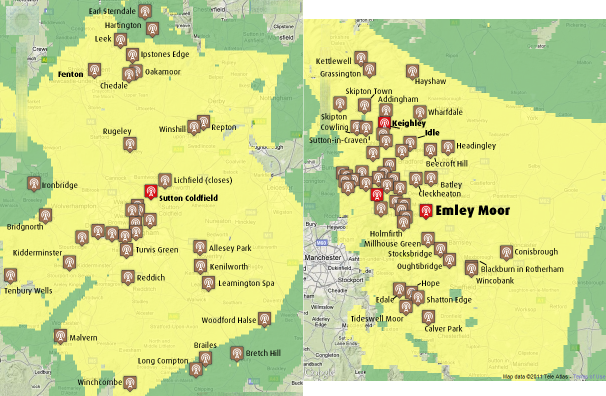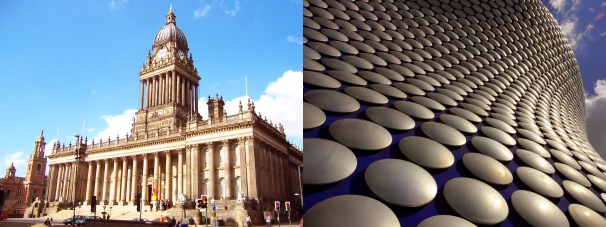Switchover starts in 4 million homes in Yorkshire, West Midlands 7th September
 Brian Butterworth published on UK Free TV
Brian Butterworth published on UK Free TV This week seems the biggest switchover event so far as 4,002,886 homes in the West Midlands and most of Yorkshire start the two-week, two-stage switchover process.
From 6am Wednesday 7th September 2011, you must to a perform a "first time installation" retune (sometimes "Factory Reset" or "Shipping Condition") on your Freeview box or television set if you use the Brierley Hill, Emley Moor, Fenton, Idle, Keighley, Malvern and Sutton Coldfield full service Freeview transmitters. This is because the old "multiplex 1" BBC service will be replaced by the BBCA multiplex on the old analogue BBC TWO frequency.
If you live in Yorkshire and use the Addingham (9am), Armitage Bridge, Batley (noon), Beecroft Hill (7.30am), Blackburn In Rotherham, Bradford West (noon), Calver Peak, Cleckheaton, Conisbrough, Cop Hill (9am), Copley (9am), Cornholme, Cowling (3pm), Cragg Vale, Cullingworth (9am), Edale, Elland, Grassington, Hagg Wood, Halifax (9am), Headingley, Hebden Bridge, Heyshaw, Holmfield, Holmfirth (noon), Hope (9am), Keighley Town, Kettlewell (noon), Longwood Edge, Luddenden, Lydgate, Millhouse Green, Oughtibridge, Oxenhope, Primrose Hill, Ripponden, Shatton Edge (9am), Skipton (9am), Skipton Town (9am), Stocksbridge, Sutton in Craven, Tideswell Moor, Todmorden, Walsden, Walsden South, Wharfedale (9am), Wheatley or Wincobank relay transmitters from 6am (unless shown otherwise) on Wednesday 7th September 2011 you will be able to receive the BBC Freeview services (with the exception of HD) for the first time, and you will no longer be able to view BBC TWO on analogue.

If you live in the West Midlands and use the Allesley Park, Brailes (9am), Bretch Hill (noon), Bridgnorth (3pm), Cheadle, Earl Sterndale, Edgbaston, Gib Heath, Gravelly Hill, Haden Hill, Hamstead, Harborne (noon), Hartington, Ipstones Edge, Ironbridge, Kenilworth, Kidderminster (9am), Kinver (noon), Leamington Spa (9am), Leek (9am), Lichfield, Long Compton, Oakamoor, Perry Beeches, Queslett, Redditch, Repton (noon), Rugeley, Tenbury Wells, Turves Green, Whittingslow, Winchcombe, Winshill (9am) or Woodford Halse relay transmitters from 6am (unless shown otherwise) on Wednesday 7th September 2011 you will be able to receive the BBC Freeview services (with the exception of HD) for the first time, and you will no longer be able to view BBC TWO on analogue.
You MAY find that old pre-Freeview equipment will no longer work - see TVs and boxes that do not support the 8k-mode

On Wednesday 21 September 2011 will see the second stage of switchover, which provides the final Freeview configuration, including Freeview HD for all transmitters in these two regions.
On this date, you will need, once again, to do a "first time installation" as indicated above. If you are over 75, you should aleady have been supplied new equipment by the Switchover Help Scheme.
11:10 PM
Can someone please tell me why Freeview has to be re-tuned 5 or 6 times a year when the analogue channels remained the same since the switch to 625 line? Digital it seems, may NOT be an improvement.
| link to this comment |
10:32 AM
Andrew Lowe: Although lots of other complexities are involved in this, but put very simply, this is because that pre-switchover multiplex transmitters were started up operating on relatively low power levels, the reason being so that they would not interfere with the more distant viewers reception of other transmitters operating on the same frequency covering an adjacent area, this usually on analogue although it could also be very low powered digital.
The switchover process involves all of these pre-switchover transmitters (usually six on a main station) significantly (as far as PSB is concerned) increasing their power levels, which if that was all that was done could then cause problems to the more distant viewers referred to, and so to avoid this happening their operating frequencies had also to be changed, this being why re-tuning is always necessary to enable viewers to keep track of the changed frequencies / channel numbers, the only reason for it having to be done on such a number of occasions (some areas) is because of the number of multiplex transmitters involved, and the automatic chain effect resulting by any change.
Analogue is/was basically a stable well established system, and this is why retuning was never really necessary.
| link to this comment |
12:00 PM
Andrew Lowe: Because analogue simply had one radio channel = one programme service, but the capacity of a digital multiplex can be sliced up many different ways to fit in many channels. The Service Information describing how each multiplex has been sliced up is continuously re-broadcast at very short intervals - your box *could* use that information to spot new channels and deleted channels, but unfortunately very few do.
An actual *retune*, a move of a multiplex from one frequency to another, is relatively rare, though as jb38 says, some sites (particularly Sandy Heath and Mendip) have had far more than others. Again, there is provision in the Service Information to describe a move of one frequency to another, but very few boxes implement it correctly.
Here, the pay-TV markets work much better than the open systems, because the provider (Sky, Virgin Media) is in full control of the hardware specification and have required that the boxes retune themselves automatically as required. Freesat equipment can require being put in standby before picking up a change, and some does require the user to select a retune.
The automatic retune features on a lot of Freeview equipment are a disaster if you're in an overlap area, as they will typically tune in the lowest frequency signals even if you specifically manually tuned to the best available. The newest equipment should handle this a lot better.
| link to this comment |
4:33 PM
Wolverhampton
Hi Briantist
I hope you can shed some light on the following problem that has occurred following the first switch to the Sutton Coldfield Transmitter. I would also have reason that all those viewers still using the old ON Digital and ITV Digital set top boxes are suffering the same fate as myself.
Back in December 2000 I purchased the Toshiba 28WT98B DTV which was the first Digital TV produced by Toshiba, then found inside was a Philips tube. No problem there..although it hasn't really worked properly since Toshiba never wrote the software to pick up the text channels before ITV Digital went bump having out stretched themselves bidding to show live football. I guess we all remember the reasons behind that.
Following the first switch last Wednesday (7th) I find that although on Analogue BBC 2 went off the air on channel 40 as planned they have put ITV 1 on Channel 40, clearing the way for the 7 BBC channels to occupy Channel 43 on the Digital system.
Since I was able to receive all 105 digital channels prior to last Tuesday night, I can only receive 98 channels now with all the BBC channels blank.
Can you explain what has occurred since Switchover and does this mean that from the 2nd switch date on 21st September myself and those who have the older Digital TV and set top boxes won't be able to pick up any channel in the conventional way and will have to buy again either a set top box or DTR to be able to view any channel.
| link to this comment |
Steveharvey04's: mapS's Freeview map terrainS's terrain plot wavesS's frequency data S's Freeview Detailed Coverage
6:52 PM
Steve
Your old equipment only had the cabability of receiving Freeview pictures using 2kb packets of digital information.
ll transmissions will now use 8kb packets of information.
All muxes will now also use 64QAM except for the HD Multiplex which will use the 256QAM format
| link to this comment |
Terry Mahon: Actually, "2k" and "8k" do not refer to "packets of information", they refer to the number of subcarriers the signal, which occupies and 8MHz block, is split into.
In fact 2k refers to 1705 and 8k to 6817.
You can (sort of) think of the signal as being split into 4kHz or 1kHz signals. This can be done because as the signals are digital and have two possible levels (0 and 1) the effect of sidebands can be ignored, which certainly isn't true if they were analogue signals.
Whilst information in the multiplex is carried in packets, this is not part of the CODFM system, but a "higher level", the MPEG-2 transport stream.
| link to this comment |
Steveharvey04: Terry Mahon isn't quite right about the meaning, but his diagnosis is essentially correct, your equipment is on this list:
TVs and boxes that do not support the 8k-mode | ukfree.tv - independent free digital TV advice
and so will no longer function. A set-top box should be swapped out for a newer model, a television set will now need to use a set-top box.
If you have equipment dating back to the 1998-2002 era, you will probably see quite a lot of benefit from using a modern box.
| link to this comment |
11:21 AM
Newcastle
I purchased a Sony Bravia TV last December which has Freeview and HD already installed. I have retuned my TV on the date requested but I am not receiving HD viewing yet? Am I supposed too or do I need to wait until 21st Sept?
| link to this comment |
jean's: mapJ's Freeview map terrainJ's terrain plot wavesJ's frequency data J's Freeview Detailed Coverage
11:24 AM
Newcastle
jean: Sorry I forgot to say I live in the Stoke-on-Trent area
| link to this comment |
jean's: mapJ's Freeview map terrainJ's terrain plot wavesJ's frequency data J's Freeview Detailed Coverage
11:51 AM
jean: HD services from the Fenton transmitter start on 21 September.
The Sutton Coldfield coverage area already has a 'temporary' HD service but this is on low power and restricted coverage (and is actually from Lichfield). The high-power, permanent, service also starts on 21 September, this time from Sutton Coldfield.
The Freeview HD predictor shows a start date at your postcode of 2 November 2009 because the Digital UK predictor reckons you are covered by the Winter Hill transmitter, which switched over on that date. You might also get a reliable service from The Wrekin.
| link to this comment |